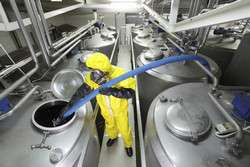Sharing knowledge for the sustainable and safe use of chemicals

HEROIC researchers have developed a roadmap towards the sustainable and safe use of chemicals, combining environmental and human risk assessments.
The key objective of the EU HEROIC project, which was officially completed in September 2014, was to identify how best to develop and promote Integrated Risk Assessments (IRAs) for regulatory use. A detailed roadmap was put together, and key project results were recently published in a White Paper.
Human health and environmental risk assessment methods have generally developed independently. In the past, regulatory agencies have often used a chemical-by-chemical approach, focusing on a single source and a single toxic endpoint. This means that data from certain toxicological studies have not always been accessible by risk assessors in other disciplines. As a result of this, possibilities for knowledge sharing have not been realised.
In recent years, there have been moves towards addressing the problem through more integrated, holistic approaches to risk assessments, which take into account real life situations of multi-chemical and multi-species exposures.
The HEROIC project White Paper, published in April 2015, details the team's progress towards making Integrated Risk Assessments a commonplace regulatory tool. Initial project work included an evaluation of current risk assessment practices, which enabled team members to identify common data needs and opportunities for improvement. These findings were discussed at a workshop in 2012 and published in a position paper in 2013 expressing HEROIC's vision for integrated risk assessment.
Cooperation has been a key theme throughout the project. In the short term, the team suggested setting up an EU task force in collaboration with regulatory authorities, in order to coordinate implementation and promote stronger international cooperation. This task force would coordinate various approaches based on a common understanding and joint definition of IRA, and provide a framework for how IRA can best be implemented in regulatory frameworks.
The project also recommended establishing stronger links between different scientific disciplines in order to achieve better cooperation. Through sharing knowledge, the various actors involved in risk assessments will be able to contribute towards developing clear, transparent and integrated IRA procedures.
A publicly accessible web portal, Tox-Hub, was created to improve communication and capacity-building among professionals. The website provides access to relevant toxicological information, including existing databases. HEROIC hopes that a sustainable platform will be established to enable stakeholders to continue to network and share knowledge.
In the medium term, the project proposed harmonising tools and methods from both human health and environmental risk assessments, by exploring how hazard and exposure data could be used across the two disciplines. Harmonisation efforts should be encouraged at every level and considered as a prerequisite for IRA, says the HEROIC team.
Finally, in the longer term, HEROIC recommends that policy makers enact new legal mandates for IRA in the most promising EU regulations, as identified by the task force to support its implementation into regulatory practice. These regulations include the REACH chemicals legislation and the Water Framework Directive (WFD).
It is clear that the development and implementation of new IRA frameworks will require sustained dialogue between all stakeholders, and will necessitate policy and regulatory changes. The HEROIC project represents a significant step forward in achieving these objectives.
More information: For further information please visit: HEROIC. heroic-fp7.eu/en/home/
Provided by CORDIS


















